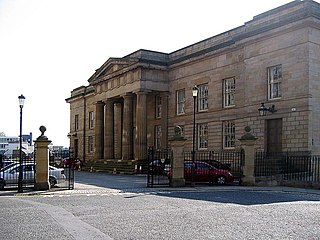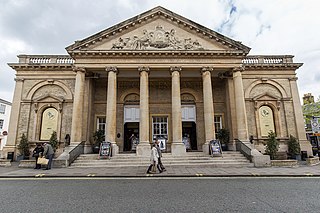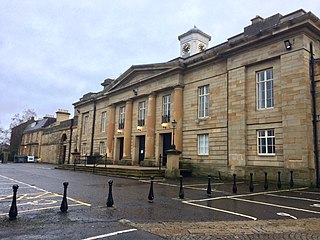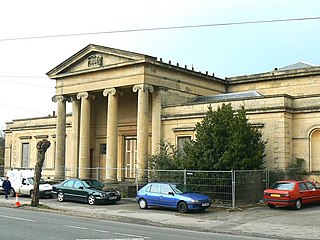
Chester Castle is in the city of Chester, Cheshire, England. It is sited at the southwest extremity of the area bounded by the city walls. The castle stands on an eminence overlooking the River Dee. In the castle complex are the remaining parts of the medieval castle together with the neoclassical buildings designed by Thomas Harrison which were built between 1788 and 1813. Parts of the neoclassical buildings are used today by the Crown Court and as a military museum. The museum and the medieval remains are a tourist attraction.

York Castle is a fortified complex in the city of York, England. It consists of a sequence of castles, prisons, law courts and other buildings, which were built over the last nine centuries on the south side of the River Foss. The now ruined keep of the medieval Norman castle is commonly referred to as Clifford's Tower. Built originally on the orders of William I to dominate the former Viking city of Jórvík, the castle suffered a tumultuous early history before developing into a major fortification with extensive water defences. After a major explosion in 1684 rendered the remaining military defences uninhabitable, York Castle continued to be used as a gaol and prison until 1929.

Lewes Crown Court is a Crown Court venue in Lewes High Street, Lewes, East Sussex, England. It forms part of the Lewes Combined Court Centre which it shares with Lewes County Court. The building, which was known as the "County Hall" from an early stage, was also the headquarters of East Sussex County Council from 1889 to 1938: it is a Grade II* listed building.

The Bristol Crown Court is a Crown Court venue which deals with criminal cases at Small Street in Bristol, England. The building, which was completed in 1868, was previously used as a main post office before it was converted for judicial use in the early 1990s.

Chester Crown Court is a judicial facility at Castle Square in Chester, Cheshire. The building, which forms part of a series of imposing buildings at Chester Castle, is a Grade I listed building.

County Hall is a historic former courthouse in Cuckoo Lane in Coventry's Cathedral Quarter. It is a Grade II* listed building.

Gloucester Shire Hall is a municipal building in Westgate Street, Gloucester. The shire hall, which is the main office and the meeting place of Gloucestershire County Council, is a grade II listed building.

St Albans Town Hall, sometimes known as the Old Town Hall or The Courthouse, is a 19th-century building in St Albans, Hertfordshire, England. The building, which now accommodates the St Albans Museum, is a Grade II* listed building.

Gloucester Crown Court is a Crown Court venue which deals with criminal cases at Bearland, Gloucester, England. The court, which is located at the back of Gloucester Shire Hall, is a grade II listed building.

The Moot Hall is a former courthouse at Castle Garth in Newcastle upon Tyne, England. The structure, which overlooks the Tyne Bridge, is a Grade I listed building.

Corn exchanges are distinct buildings which were originally created as a venue for corn merchants to meet and arrange pricing with farmers for the sale of wheat, barley, and other corn crops. The word "corn" in British English denotes all cereal grains, such as wheat and barley. With the repeal of the Corn Laws in 1846, a large number of corn exchanges were built in England, particularly in the corn-growing areas of Eastern England.

Reading Crown Court is a judicial facility in Reading, Berkshire. It is a Grade II listed building.

Lincoln Crown Court is a judicial facility in Lincoln, England. It is located on the western side of the grounds of Lincoln Castle and is a Grade II* listed building.

The Teesside Combined Court Centre is a Crown Court venue, which deals with criminal cases, as well as a County Court venue, which deals with civil cases, in Corporation Road, Middlesbrough, England.

The Oxford Combined Court Centre is a Crown Court venue, which deals with criminal cases, as well as a County Court venue, which deals with civil cases, in St Aldate's, Oxford, England.

Durham Crown Court is a Crown Court venue which deals with criminal cases at Old Elvet, Durham, England. Located immediately to the north of Durham Prison, it is a Grade II* listed building.

Guildford Crown Court is a Crown Court venue which deals with criminal cases in Bedford Road, Guildford, England.

Shrewsbury Justice Centre is a Crown Court venue which deals with criminal cases, in Preston Street, Shrewsbury, England.

The Sessions House is a judicial structure in Toft Road, Knutsford, Cheshire, England. The structure, which used to be the main courthouse for the eastern part of the county of Cheshire, is a Grade II* listed building.

Devizes Assize Court is a judicial building in Northgate Street in Devizes, a town in Wiltshire, England. The building, which is currently vacant and deteriorating, is a Grade II* listed building.





















